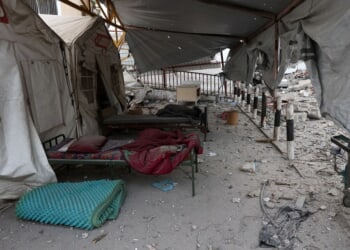A key factor driving this new North Korean modernization push is undoubtedly Pyongyang’s ever-growing closeness with Moscow.
North Korea is making significant strides in modernizing their massive military. The primary goal of North Korea’s Armed Forces is clearly to obliterate the U.S.-backed South Korean military in war. But Pyongyang is also interested in deterring Washington and Seoul from being able to threaten the regime of North Korea—hence why Pyongyang remains steadfast in its commitment to acquire and keep its nuclear weapons arsenal.
Now comes another round of news out of the region indicating that North Korea’s military modernization extends to advanced drone technology—even possibly AI-equipped kamikaze drones.
North Korea’s New Drones
North Korea’s strategic reconnaissance drone is designed for intelligence gathering and surveillance. According to reports from South Korea’s Yonhap News Agency, the new drone is capable of tracking and monitoring various strategic threats, including enemy troop movements on land and at sea. The drone is part of a broader effort to bolster North Korea’s ability to collect real-time intelligence, a critical component of modern warfare.
State media has showcased images of Kim Jong-un inspecting a large reconnaissance aircraft, which appears to be a converted Russian-made Il-76 cargo plane equipped with a radar dome on its fuselage. Indeed, this aircraft bears a close resemblance to airborne early-warning and control (AEW&C) systems, such as South Korea’s Boeing-manufactured Peace Eye. Such an aircraft could enhance North Korea’s ancient air defense network by augmenting its land-based radar systems, which are often limited by the peninsula’s mountainous terrain.
The ability to conduct high-altitude surveillance could provide North Korea with improved detection of low-flying aircraft and cruise missiles, addressing some of the shortcomings of its current infrastructure.
As the Ukraine War has proven, loitering munitions—or “kamikaze drones”—are some of the most effective and lethal systems in modern combat. North Korea has invested significantly in these drones, which are designed to loiter over a target area, identify a target, and then crash into that target and detonate their explosive payloads.
North Korea has successfully tested these kamikaze drones. The drones accurately identified and destroyed targets during demonstrations supervised by Kim Jong-un, according to North Korean state media. A notable advancement has been the incorporation of AI into these drones, enhancing their precision and autonomy. The AI technology reportedly allows the drones to track targets, adjust flight paths, and execute tactical attack missions with greater effectiveness.
North Korea’s suicide drones are likely to come in various configurations, tailored for different striking ranges and missions. They are intended to attack both ground and maritime targets, making them versatile tools for tactical infantry and special operations units.
How Did North Korea Develop This AI?
Kim Jong-un has emphasized the importance of AI in modern arms development, calling for its prioritization alongside unmanned equipment to modernize North Korea’s Armed Forces. The North Korean dictator pushed for expanding production capacity and establishing a long-term strategy to accelerate the development of “intelligent drones,” reflecting on their perceived value in contemporary conflicts.
By focusing on drones, Pyongyang is radically altering the strategic landscape on the Korean Peninsula. It already has a larger military than its South Korean rivals. Yet, the South Koreans could always rely on two major factors: better technology, and their alliance with the United States.
The systems that Kim Jong-un is directing his military to invest in, however, are fundamentally changing at least one side of the ledger. And as the Trump administration intently looks for new ways to lessen its international military obligations, the advances occurring right now in North Korea could prove decisive for Pyongyang.
A key factor driving this new North Korean modernization push is undoubtedly Pyongyang’s ever-growing closeness with Moscow. At a time when much of the rest of the world turned its back on Russia following their invasion of Ukraine, North Korea has moved closer to Russia. In turn, that has granted Pyongyang a level of unprecedented access to more advanced military equipment they have not enjoyed with Russia in years.
The Balance of Power on the Korean Peninsula is Shifting
This access is proving to be a real game-changer. Indeed, Russia’s contributions to North Korea’s Armed Forces may be even more consequential than Pyongyang’s assistance to Russia in Ukraine.
Kim Jong-un has highlighted the drones’ low production costs and simplicity, positioning them as a practical addition to North Korea’s arsenal amid its ongoing nuclear and missile programs.
Make no mistake, North Korea is rapidly progressing its military. South Korea must be vigilant as never before.
About the Author: Brandon J. Weichert
Brandon J. Weichert, a Senior National Security Editor at The National Interest as well as a contributor at Popular Mechanics, who consults regularly with various government institutions and private organizations on geopolitical issues. Weichert’s writings have appeared in multiple publications, including the Washington Times, National Review, The American Spectator, MSN, the Asia Times, and countless others. His books include Winning Space: How America Remains a Superpower, Biohacked: China’s Race to Control Life, and The Shadow War: Iran’s Quest for Supremacy. His newest book, A Disaster of Our Own Making: How the West Lost Ukraine is available for purchase wherever books are sold. He can be followed via Twitter @WeTheBrandon.
Image: Shutterstock / Shutterstock AI.














